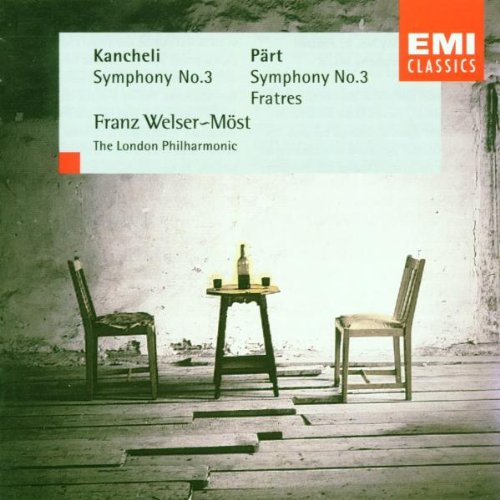Pärt & Kancheli Orchestral Works
View record and artist detailsRecord and Artist Details
Composer or Director: Arvo Pärt, Giya Alexandrovich Kancheli
Genre:
Orchestral
Label: EMI
Magazine Review Date: 8/1996
Media Format: CD or Download
Media Runtime: 55
Mastering:
DDD
Catalogue Number: 555619-2

Tracks:
| Composition | Artist Credit |
|---|---|
| Symphony No. 3 |
Arvo Pärt, Composer
Arvo Pärt, Composer Franz Welser-Möst, Conductor London Philharmonic Orchestra |
| Fratres |
Arvo Pärt, Composer
Arvo Pärt, Composer Franz Welser-Möst, Conductor London Philharmonic Orchestra |
Author:
Here is a natural and effective coupling of spiritual-minimalist pieces from the Baltic and the Balkans; and how good it is to see this music at last on a major label with a top-flight international orchestra.
The benefits are clear in Kancheli’s Third Symphony, with its extreme contrasts of solo vocal keening and tutti Stravinskian outbursts. Here the spaciousness of EMI’s recording, made in Watford Town Hall, and the refinement of the LPO’s playing are clear gains over the rival Georgian performance (which comes with the added drawback of having been transferred a whole tone too high by the original Melodiya team). The mesmeric folk-derived lament which punctuates the structure was sung on the earlier recording by Rustavi choir-member Gamlet Gonashvili, for whose unearthly tenor Kancheli conceived it. On the new issue David James’s ethereal countertenor, familiar from his work with the Hilliard Ensemble, is a valid alternative and one sanctioned by the composer.
Franz Welser-Most’s basic tempo for the piece is less extreme than Kakhidze’s, giving an overall duration of 23'30'' as against 30'11''; by the same token the impression of hypnotically sustained timelessness is slightly diminished. So for the fullest appreciation of this extraordinary music, both versions are needed.
Part’s Third Symphony, composed in 1971, two years before Kancheli’s, is something of a half-way house in the composer’s journey towards his now famous ascetic minimalism. Its chant-based archaisms sit rather oddly beside reminders of the twentieth-century mainstream, like a meditation annoyingly distracted by the outside world. Part’s real breakthrough came with pieces like Fratres, which first appeared six years later, where the technical means are even slighter but the contemplative end is the more fully realized.
The performance of the symphony is, by the smallest of margins, more refined than that of its dedicatee Neeme Jarvi on BIS, though that rival version does have the other two symphonies Part symphonies as the valuable couplings. Fratres is beautifully shaded and sustained by Welser-Most and his players, as it is on the rival Teldec recording of seven different versions of the piece.
This review gives me the chance to confess that my essay for EMI’s CD booklet gives the wrong date and version number, thanks to my misreading of the publisher’s catalogue; Version VI, 1991, as given on the booklet’s title-listing, is correct.'
The benefits are clear in Kancheli’s Third Symphony, with its extreme contrasts of solo vocal keening and tutti Stravinskian outbursts. Here the spaciousness of EMI’s recording, made in Watford Town Hall, and the refinement of the LPO’s playing are clear gains over the rival Georgian performance (which comes with the added drawback of having been transferred a whole tone too high by the original Melodiya team). The mesmeric folk-derived lament which punctuates the structure was sung on the earlier recording by Rustavi choir-member Gamlet Gonashvili, for whose unearthly tenor Kancheli conceived it. On the new issue David James’s ethereal countertenor, familiar from his work with the Hilliard Ensemble, is a valid alternative and one sanctioned by the composer.
Franz Welser-Most’s basic tempo for the piece is less extreme than Kakhidze’s, giving an overall duration of 23'30'' as against 30'11''; by the same token the impression of hypnotically sustained timelessness is slightly diminished. So for the fullest appreciation of this extraordinary music, both versions are needed.
Part’s Third Symphony, composed in 1971, two years before Kancheli’s, is something of a half-way house in the composer’s journey towards his now famous ascetic minimalism. Its chant-based archaisms sit rather oddly beside reminders of the twentieth-century mainstream, like a meditation annoyingly distracted by the outside world. Part’s real breakthrough came with pieces like Fratres, which first appeared six years later, where the technical means are even slighter but the contemplative end is the more fully realized.
The performance of the symphony is, by the smallest of margins, more refined than that of its dedicatee Neeme Jarvi on BIS, though that rival version does have the other two symphonies Part symphonies as the valuable couplings. Fratres is beautifully shaded and sustained by Welser-Most and his players, as it is on the rival Teldec recording of seven different versions of the piece.
This review gives me the chance to confess that my essay for EMI’s CD booklet gives the wrong date and version number, thanks to my misreading of the publisher’s catalogue; Version VI, 1991, as given on the booklet’s title-listing, is correct.'
Discover the world's largest classical music catalogue with Presto Music.

Gramophone Digital Club
- Digital Edition
- Digital Archive
- Reviews Database
- Full website access
From £8.75 / month
Subscribe
Gramophone Full Club
- Print Edition
- Digital Edition
- Digital Archive
- Reviews Database
- Full website access
From £11.00 / month
Subscribe
If you are a library, university or other organisation that would be interested in an institutional subscription to Gramophone please click here for further information.




